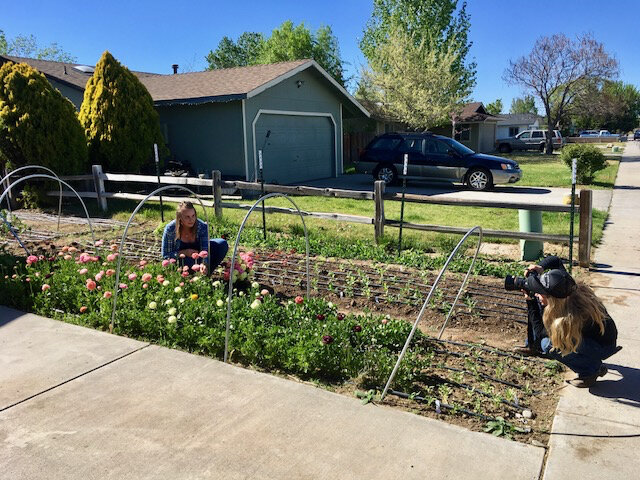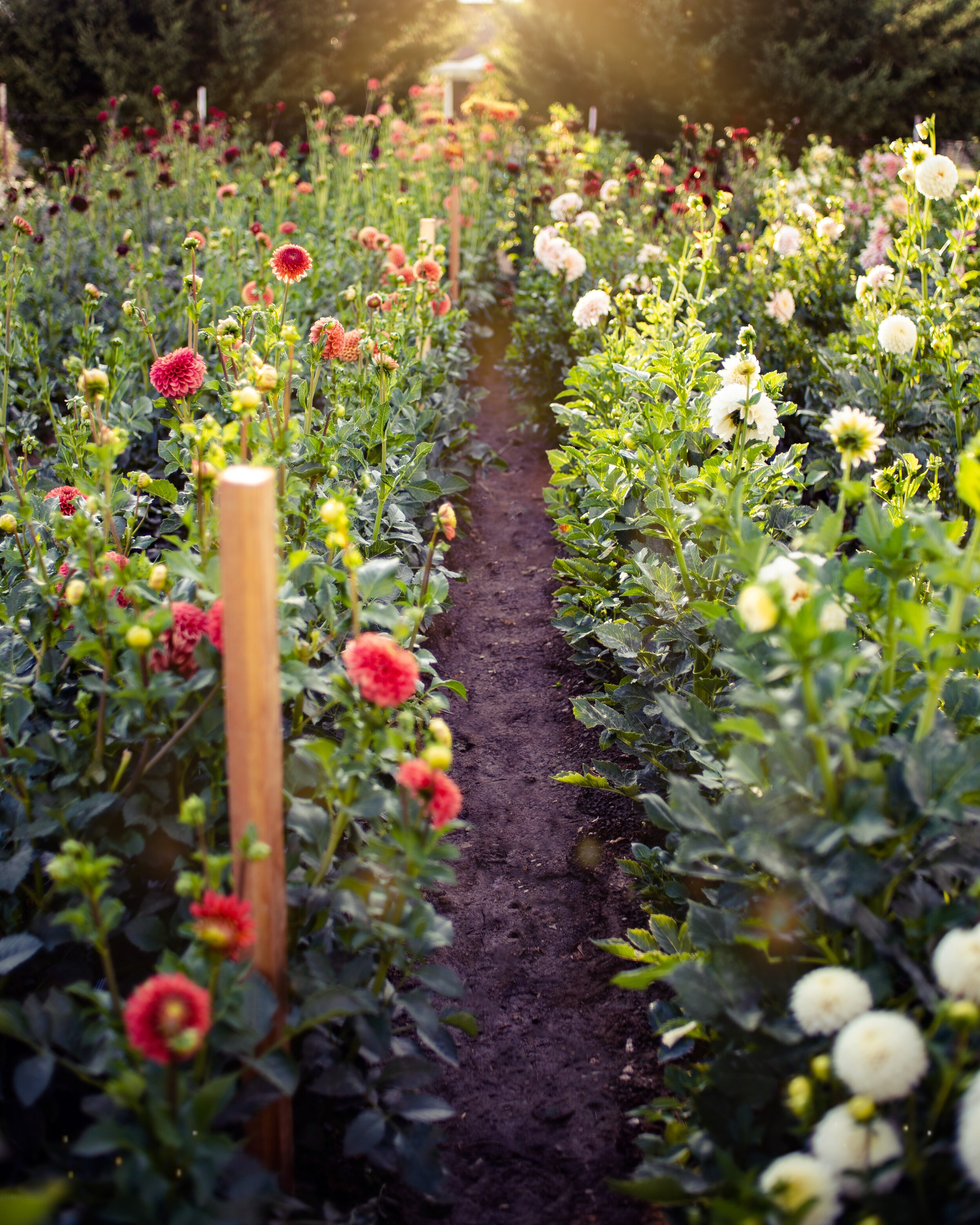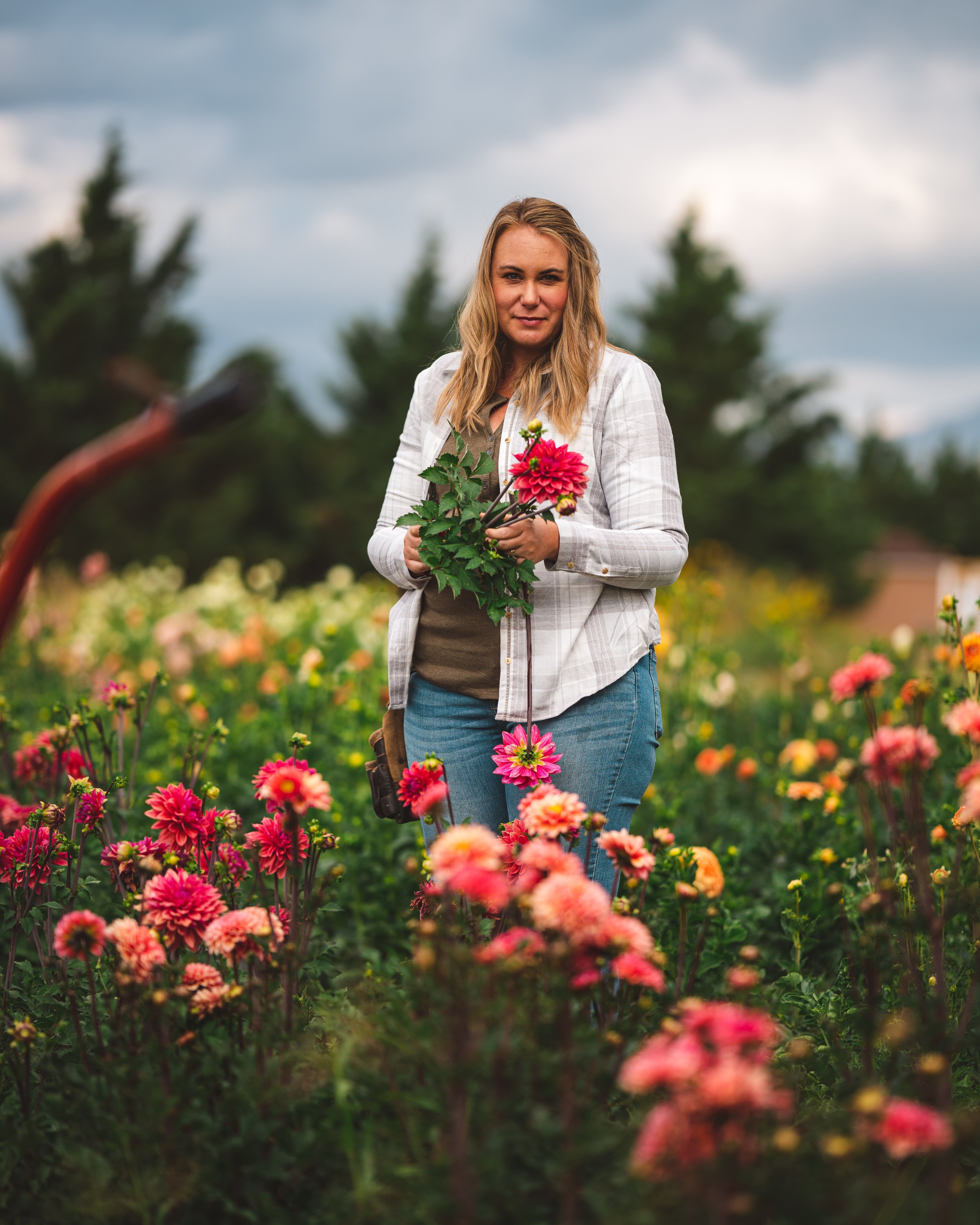5 Things I wish I knew about growing our first year flowers
Coming into our fifth growing season I can look back now and see incredible amounts of mistakes (or really, how I like to think of them, opportunities to learn) along with all the hustle of our first year of flower farming. If having one first year is not enough, we essentially had a second first year all over again when we moved to our current property in late summer 2018. Two times we have had first year experiences and it wasn’t until the second time around we learned some really vaulable lessons.
Looking Back on our journey
We started Sierra Flower Farm with very little financial backing on a tiny piece of property. The first year, we made many mistakes in the haste to launch into this dream. I had a couple seasons of growing vegetables in our garden under my belt with some flowers peppered in for companion planting. I did not go to college to learn horticulture or floriculture nor did I take any classes (in person classes were outside our financial abilities and online wasn’t a thing back then). I went to college for business because getting a minimum of a BA was on my bucket list. To be honest, I thought I would go higher up in my college education but alas, different plans were made for me. If it wasn’t for the sequence of events that happened out of my control, I’m not sure flower farming would have become a passion of mine. At least, not at my younger age!
At the time, I was seeking. I was seeking for something to fill my time and my heart. Staying home with my babies was something I never saw myself doing. Until they came and that’s all I wanted. I quickly realized that I was not content “just being a stay at home mom.” I was going stir crazy! On a limited budget, with limited time and limited land I launched into this journey of flower farming and dragged my husband with me.
If you’ve read my blog Advice for first year flower farmers and dreamers then you know that a lot of the tough lessons were more emotional.
Fast forward to Sierra Flower Farm 2.0. We knew that we had outgrown our property and if we were content at keeping the business at it’s size it would have worked! That property and our hodge-podge of rows that made a grand total of 1,500 square feet of growing space (at best!) allowed us to work a beautiful weekly Farmer’s Market, take on some weddings and bulk buckets, a bouquet subscription (at peak, about thirty members per week) and be a core vendor at a cute pop-up shop one weekend a month. In between that, we did other small events. It did get to the point where literally every stem was sold before it was even harvested, it was rather intense! It worked and we could have had a small successful business at that level. The thing is, we wanted to grow more and provide more flowers. The small property opened the doors and allowed us to launch Sierra Flower Farm but it was only the beginning.
Sometimes things just land on your lap and it happens fast.
That’s what happened with Sierra Flower Farm 2.0. We upgraded from 2/10 of an acre lot to a home on one acre. Okay… the house needs some work and every time we turn around we are fixing huge problems due to years of neglect. The problems have gotten less, but it’s a definite fixer upper! Still, it’s our fixer-upper and it was in our budget and now we have tons more space to grow!
Out in the field, it looked to home some kind of horse or some type of livestock way back when. Otherwise the land was just left alone with the exception of being sprayed twice a year with glysophate and pre-emergent to battle tumbleweeds. We thought detoxing the soil would give us a level playing field, which I think did help but that wasn’t going to be out biggest battle.
So here are our top five things relative to growing I wish I knew after having two separate “first years” in flower farming:
1- Soil Test
You will hear how imperative a soil test is. You know it is. That doesn’t mean in the beginning stages we are all responsible and have one done out the gate. Even soil that perhaps you gardened in before and you had a “good enough” result should be tested.
If you want solid quality blooms a professional soil test from a grown up lab, such as a local extension office, is a must. However, for a few seasons, on our last property, we got by putting it off.
I remember telling Graham that we needed to have this done. He gave me the choice of a soil test or being able to buy soil amendments. We were that tight on a budget that to spend the money on the test, in our minds, meant we didn’t have it in the budget to be able to do anything with it. In hindsight, even on our limited budget the soil test would have saved us. We bought amendments retail, just guessing off of what we know the plants needed. To make matters worse, we were innocently misguided by someone who previously flower farmed. I asked about a soil test and they shrugged it off saying they never bothered to just feed the basic nutrients that the plants need. Well, I was two against one at that point. I doubted myself. On the last property we got lucky.
It wasn’t until Sierra Flower Farm 2.0 that trouble brewed.
In the haste of moving to a new property and selling the last one, we rushed more than ever. We had already had signups and payments for our spring bouquet subscription, we were already committed to orders of spring bulbs placed the previous June (months before even realizing we were buying a new property, let alone planting there!).
Needless to say, we did not make a soil test a priority as we should have. Especially when considering the abuse from herbicides and who knows what else. We paid for it. If we would have gotten a soil test, we would have known what we were dealing with. We are just now finding out definitively what we are working with and against. We have come to realize our guessing and what we were actually working with mixed together created the perfect storm that did not end with the most desirable results… so get a professional soil test! Better yet, get one every fall!
2- Understanding how to apply frost dates and hardiness zones to seed starting
Okay, I don’t think I am alone on this. This is a whole topic on it’s own. Reading the seed packets, especially those from seed suppliers for professionals have all the growing information you need. The part that is tricky is how to decipher it and apply your frost dates and hardiness zones to it. When you are reading “start four weeks before last frost date” it is the frost date that is relative to that particular variety. We are not looking at average frost dates like a hobbyist gardener and it can get really dizzying trying to figure it all out. Well your in luck! Everything that I wish I knew in the beginning about applying frost date info we have put in a concise and straightforward video. Check it out on YouTube, where I give a rundown on all these concepts, and if you’re more of a reader you can read the corresponding blog here.
3- Invest in quality professional potting soil, seeds, corms, bulbs and tubers
This is a lesson we learned the hard way from the very beginning. In the name of trying to save some money we opted to make our own potting soil from a recipe we found online, with a few of our own alterations. Terrible, terrible idea! Our good friends and mentors told us making our own potting soil was a bad idea, that we were going to cost ourselves more time and money… we had to learn the hard way. Don’t learn the hard way! Buy some sunshine pro mix and let them figure out the ratios and nutrients, benefit from their work! Okay, maybe you aren’t as crazy thinking of making your own but your thinking you’ll just run to the store and snag some MiracleGrow or something. Don’t do it! Buy high quality, fluffy with lots of perlite. Honestly, the quality of potting soil is going to make or break your seed starting endeavors which if you are looking to grow like the professional flower farmers you will need to get comfortable seed starting. To learn more about seed starting check out our blog on that here.
Okay, I guess I kind of lumped two together. Along with getting bulk quality potting soil I also recommend researching quality seeds, corms, tubers and bulbs. If you want to become a professional grower skip the retail purchases and opt for wholesale. All those $4-5 packets of 15-100 seeds adds up quick! Even if you don’t think you have enough room or need that much of one variety, the price point drops significantly! Especially with seeds and corms: buying from a reputable wholesaler will save you money and you will most likely attain a better product.
You may have to take a closer look at your crop planning but truly growing less varieties in exchange for higher quality and quantity of the same will make it easier on you to assemble products. From someone who grew a little bit of everything, it made it more time consuming to pull together the end product. As someone who bought too many seeds and such retail, trust me, you can get way more for a lot less money with a higher germination rate from professional suppliers. For each retail purchase I made, it ate into my potential profit. Stick with some basic varieties of flowers, don’t invest into crazy expensive dahlia tubers until you learn how to grow, profit, store and propagate from them. Warning: you most likely won’t learn this your first year flower farming. Having more corms, seeds and such on hand will give you more to experiment with. You will have crop failure. Having 1,000 of a variety of seed compared to twenty will make that loss less so. You will have the seed on hand to try again!
Pause for a shameless plug!
Enjoying the content and ready to take a leap into flower farming?! Be sure to sign up for our flower farming newsletter to get our latest blogs and videos!
Now back to the blog!
4- Drip tape, drip tape, drip tape!
Irrigation and having drip tape is life changing. On the first property, we already had irrigation in but used those funky “soaker” lines you find from Home Depot our first year flower farming. Once we replaced those overpriced pieces of junk with drip tape we found more efficient watering and thriving plants. Less water to waste and happier plants, win-win! So ditch irrigation from the big box stores and source supplies from a professional place like Dripworks.
Overhead watering isn’t effective in our arid climate. Also, overhead watering can breed fungus and disease, leading to crop failure. Unlike many other crops, most flower varieties are fairly sensitive to overhead watering. It can easily lead to blemished blooms.
Sierra Flower Farm 2.0’s irrigation was non-existent. This property…ugh… was so not taken care of. The existing irrigation is a hot mess and is something we still need to completely redo but for now, it’s fixed enough. Out in the field there was zero irrigation. We had plants in the ground weeks before irrigation was able to be installed. Hand-watering twenty rows of fussy plants (on top of them already struggling because of awful soil) was not fun. It was every morning and night sometimes during lunch breaks. It was a game of rock-paper-scissors because no one wanted to spend over an hour dragging a hose around inefficiently hand-watering! The plants weren’t happy and the farmers weren’t either.
Commit to an irrigation system. Especially if you are in a more dry climate. Use drip tape. Have it all on a timer. There are tons of tasks to be done and if you are inefficiently watering, it will eat up your time and cause non-thriving blooms.
5- Bloom where you are planted
The first-first year of flower farming we invested much of our spring in trying to launch our business, our vision, on a property far away. We were using growing methods we didn’t really want to because we didn’t think we had enough growing space on our own property. Well, it turns out we had more than enough space to launch this flower farming endeavor. Once we embraced where we were planted: it began to bloom. That tiny property opened the door and the business has grown with us. Honestly, it wasn’t until our third season there that we were bursting at the seams and was in need of more space! That is when the door opened for the new property, which I anticipate is just another stepping stone, we are embracing once again where we are planted. Even if you have tiny space, unless you are growing off a property you own, you can easily get to and has an amazing set up to fit your needs: stay close to home. Having to drive an hour away didn’t work out in my favor under my circumstances. Being close to your growing operation, especially in the beginning, is incredibly valuable. Crazy winds? You can rush out in your robe in the middle of the night to hunker down tunnels! You are there to nurture and maintain your growing operation. If you are more than twenty minutes away, that comes with some new battles. Even if you are growing on a tiny scale, do not be ashamed. I battled this a ton, I was ashamed of how ridiculously small of an operation we had. Now, I can look back and be proud. We started something from essentially nothing.
I already mentioned what we were able to accomplish with that tiny property in the beginning but I am going to do it again. From June through September we were vendors at a high-traffic Saturday morning farmer’s market, we did weddings, offered bulk buckets, had a decent bouquet subscription, were core vendors at a very popular pop-up shop, did other small events and somehow even landed in a local magazine… with 1,500 square feet of growing space! That’s not harvesting from 1,500 square feet at one time, we would have a few beds that had flowers harvestable at any given time. It was intense but completely doable! We were making stuff happen and working within our means.
You don’t need to have acres to launch your flower farming dream!
There you have it, tough lessons and tasks I wish we did our first year growing (in some cases for both properties!). A simple soil test would have saved us time, money and crop failure/struggles. Figure out how to crop plan based off your microclimate and within your means of operation. Don’t go “cheap” or “DIY” in foundational areas of the growing operation such as potting soil: invest in quality, bulk potting soil. Purchase seeds, corms, tubers, etc from a reputable wholesaler. You will have happier, healthier seedlings for a fraction of the cost. Save yourself time and be water conscious by starting off with a solid irrigation system that uses drip tape and timers. Lastly, bloom where you are planted. Own where you are- small or big, you can do this! Work within your means. Flower farming is not one size fits all and not every flower farm looks the same. That’s okay! That’s what makes flower farming so special, it’s what will make your flower farm unique.
Happy Flower Farming!
We are looking forward to helping you hand blooms soon!
- Jessica & Graham









